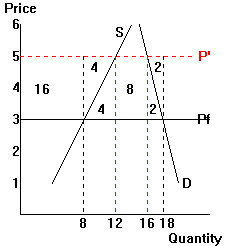| 1. |
Suppose the U.S. is a small country in the global
heavyweight motorcycle market. Consider the following about the approximate impact of U.S.
tariffs imposed in the 1980s in the heavyweight motorcycle market (quantities are in
1000s): |
|
|
| |
Free trade |
$600 tariff |
| U.S. price |
$3,400 |
$4,000 |
| Quantity consumed (Qd) |
200 |
150 |
| Quantity produced (Qs) |
100 |
125 |
|
|
a. |
Contrast the free trade and tariff situation in a domestic
market supply and demand diagram. |
|
b. |
Use information from the diagram to compute the value of the
following effects of the tariff, and indicate where each one shows up in your diagram: (1)
Change in consumer surplus, (2) Change in producer surplus, (3) Tariff revenue, and (4)
Welfare cost of the tariff |
|
c. |
An economic study estimated that the tariff created 700 jobs
in the domestic motorcycle industry. How much did each of these jobs "cost" U.S.
consumers? How much did each one cost the economy? |
 |
|
|
